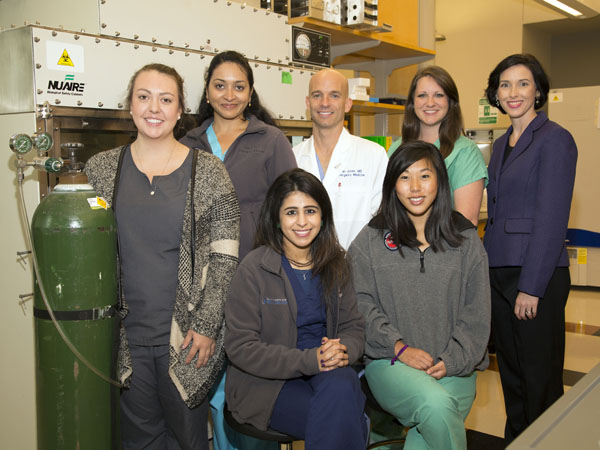Unlocking the secrets of sepsis

For the past decade and a half, Dr. Alan Jones has stared down the often-deadly sepsis infection.
Not in his own bloodstream, but in a research laboratory.
Jones, chair of the University of Mississippi Medical Center's Department of Emergency Medicine, has studied sepsis in clinical trials before and after coming to the Medical Center in 2011. His research goals include finding ways to lessen the effects of a nasty disease that can make the body attack its own organs and often results in a patient being placed on a ventilator.
“It can be devastating and result in rapid death,” said Jones, professor of emergency medicine. “The mortality rate when it progresses to septic shock is 40 percent. Only about one in two patients will live.”
Sepsis is an extreme reaction to an infection, most commonly pneumonia or a urinary tract infection. When such an overwhelming immune response to an infection occurs, chemicals released into the blood to fight the infection also trigger inflammation that can cause organs to fail. In the worst cases, a person's blood pressure plummets, causing septic shock and often death.
First recognized in the early 1700s as a condition that rapidly progressed after someone developed an infection, sepsis moved into the limelight in the Jackson area after legendary television anchor and newsman Bert Case was hospitalized with it on August 31. Case is slowly recovering, but the disease nearly killed him.
“There's no way to prevent it,” Jones said. “It needs to be recognized and treated early, before it gets bad.”
It's been proven through research that some people can be genetically predisposed to getting a more severe inflammatory response to infection, and that if you have sepsis once, you're prone to it recurring. Jones has designed and directed clinical trials sponsored by the National Institutes of Health that explore ways to diagnose sepsis earlier in the infection process, and to treat the patient by changing the chemicals present in the bloodstream.
Jones is presently the principal investigator for a multi-center clinical trial that is coordinated out of UMMC and is being conducted in 15 U.S. academic medical centers taking part.
“We're doing studies to develop markers in the bloodstream to determine the imprint that sepsis may be present sooner than is clinically apparent,” Jones said. “We're also doing a trial to give patients replacement of a nutrient, carnitine, that allows energy production and metabolism to be more efficient.”
Carnitine is a substance the body uses to efficiently turn fat into energy. Giving the body additional carnitine can improve the ability of certain tissues to produce energy at a time when an infection like sepsis is draining the body's energy, which causes problems with breathing and often triggers an altered mental state.
“By providing this nutrient, we believe patients will heal faster and recover more quickly than those who don't get the nutrient,” Jones said. “It provides energy.”
It's that lack of energy production that can in part cause a patient with sepsis to rapidly deteriorate as he becomes weak, dizzy and confused. Patients with other risk factors that suppress their immune system - for example, if they're on chemotherapy or cope with a chronic disease condition - “have a harder time fighting infection, and a harder time getting over the disease process,” Jones said.

Holmes
Andra Holmes of McComb is taking part in the sepsis trial at UMMC, which entails being interviewed about her condition, traveling to the Medical Center for follow-up physical exams, and a number of medical tests. After repeated bouts of sepsis, she knows well how taxing the infection can be on her body and well-being.
“I've never had the flu, but I guess it would be like that. I'm achy. Everything feels tired,” said Holmes, 51. “I've had it four or five times, and I have to go to the hospital each time.”
If she doesn't, Holmes said, the quickly progressing infection can kill her within hours. “I'm getting used to it,” she said of sepsis. “I know what to do.”
Holmes met Jones during her most recent stay at UMMC's intensive care unit. “When he asked me later if I'd like to do the trial, I told him, 'there's nothing to think about. I'll do it.' ”
Research shows that a person's race isn't a factor in the development of sepsis, but sex can be. “It affects males more often than females,” Jones said.
In 2011, Jones led another national study that focused on septic shock. That study suggested the window for treating septic shock patients with antibiotics at an emergency room is longer than previously thought. It showed mortality rates were no different with each passing hour, for up to six hours, for patients given antibiotics after emergency room arrival. The previous treatment guidelines recommended giving antibiotics in the first hour after septic shock recognition.
Sepsis isn't rare. It's the 10th leading cause of death nationally, with about 1 million cases treated annually, Jones said. “We probably treat between 400 and 500 cases a year at UMMC,” he said. “If it's a severe form that progresses to shock, about half will die,” and that equates to 20-30 percent of those seen annually at the Medical Center.
Treatment for sepsis patients at UMMC “is aimed at killing the bacteria and supporting the body to give it a chance to heal,” Jones said. That often includes high doses of antibiotics, placing a patient on a ventilator or on kidney dialysis, or inducing a coma, he said - measures that are frightening to family members, but can allow the body to heal itself.
“The cornerstone treatment is early recognition and getting antimicrobials (antibiotics) into the patient's system as fast as we can,” Jones said. “'We need to replace their fluids as fast as we can.”
Especially in patients who get a urinary tract infection or pneumonia, he said. “can have a perfect storm. It's aggressive, and genetics can make you have a heightened response. Very young and very old people can have a harder time fighting infection and a harder time getting over the disease process.”
UMMC, with its high volume of patients and especially those with sepsis, is well suited to treat the most dangerous infections, including repeat infections such as those suffered by Holmes, Jones said. The Medical Center's battle plan, he said, is “knowing what to do, recognizing it early and treating it aggressively.”
Her health, Holmes said, is sometimes precarious even without a sepsis infection. “I'm a cancer survivor. I'm a kidney transplant,” she said. “I have to be very careful, and I had to quit working.”
Even if her role in the trial doesn't give her final relief from her sepsis, Holmes said, she's glad to be part of the research.
“Maybe I can help someone else,” she said. “That's all I can hope for.”


